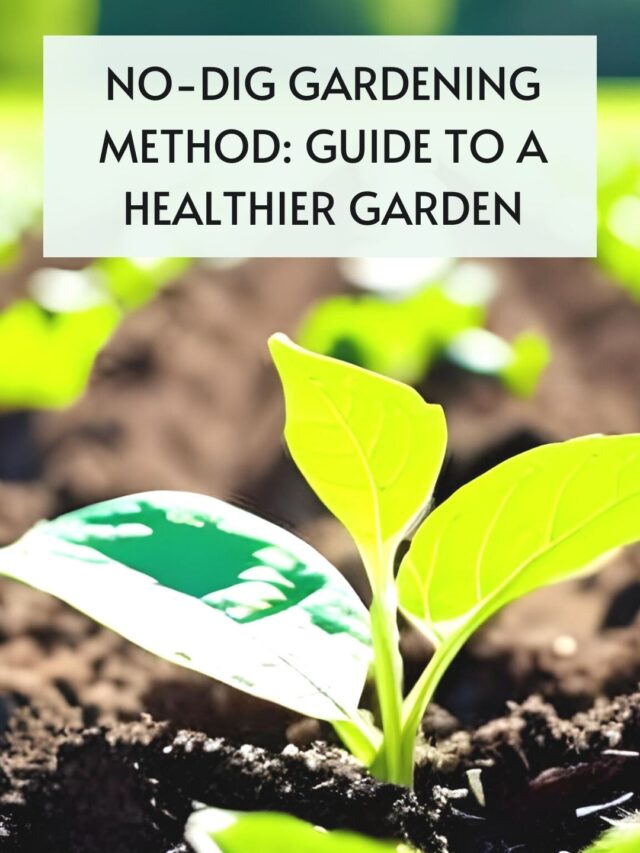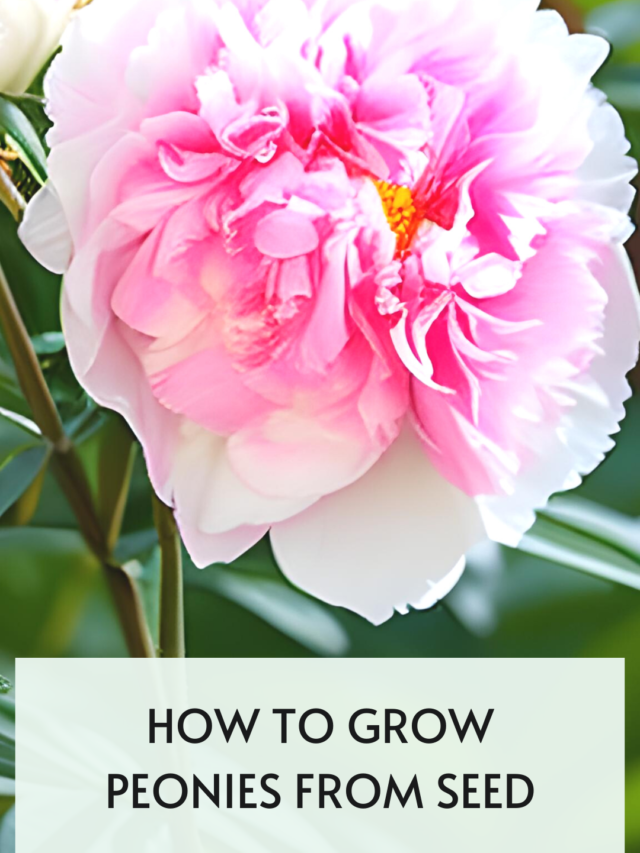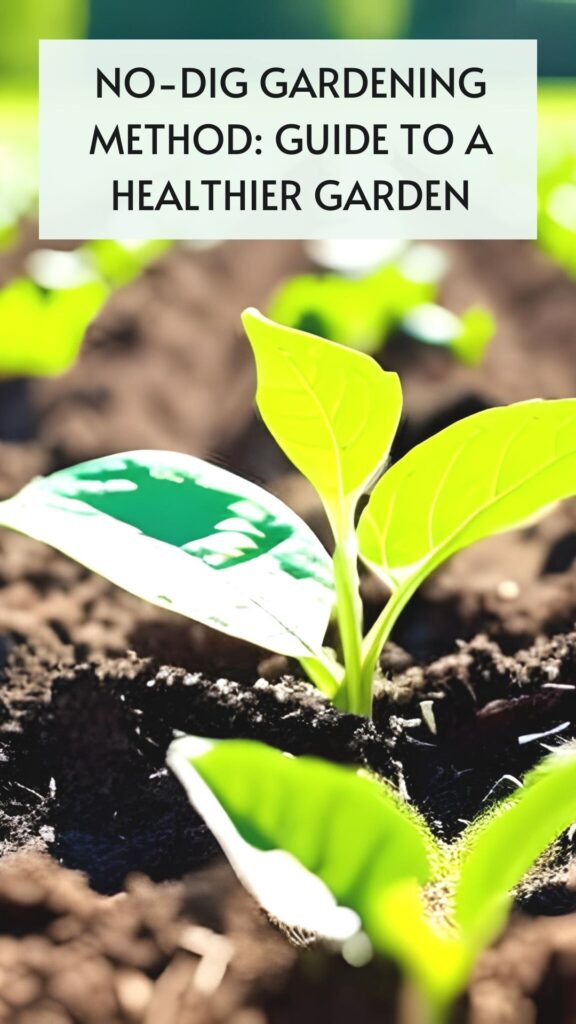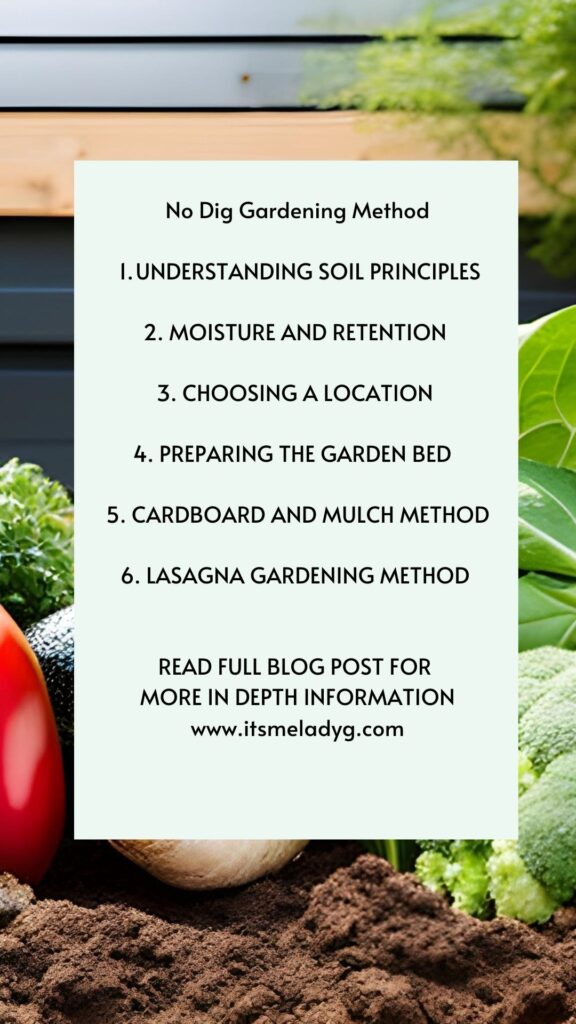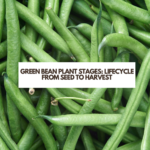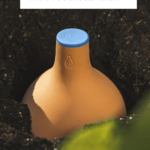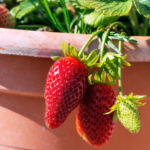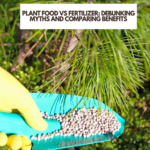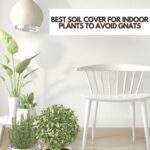Are you ready to try the no-dig gardening method? No dig gardening has gained popularity among gardening enthusiasts as a sustainable and effective method for growing plants. This innovative approach to gardening eliminates the need for disruptive soil cultivation, instead fostering a nutrient-rich environment that promotes healthy plant growth. By implementing no dig gardening techniques, gardeners can significantly reduce the time and effort required to maintain their gardens, while also encouraging the natural processes that improve soil health.
FTC DISCLOSURE: Some of the links in this post are affiliate links. If you click on them and make a purchase, I will receive a small finder’s fee on the sale. This does not increase your price in any way shape or form. Using these links help support the continuation of this website. All opinions are my own. Thank you in advance.
At the core of the no dig gardening method is the concept of layering organic materials, such as compost and mulch, on top of the existing soil. This creates a thriving ecosystem for microorganisms and earthworms, which are essential in forming healthy soil structure and nutrient cycling. As these beneficial organisms break down the organic matter, they aerate the soil and make vital nutrients more readily available to plants.
Gardeners who practice no dig gardening will also find that their gardens require less water and experience fewer issues with weeds and pests.
The method creates a moisture-retentive environment that keeps the soil cool and damp, reducing the need for frequent irrigation. Additionally, the suppression of weeds and pests through the use of natural processes minimizes the need for chemical interventions, making no dig gardening a truly eco-friendly approach to growing plants.
You Might Also Like Reading:
How To Choose The Best Containers For Container Gardening
No Dig Gardening Principles
Importance of Soil Structure in no-dig gardening methods
No dig gardening is a method that focuses on preserving soil structure by eliminating the need for tilling. Tilling can cause soil compaction, erosion, and disrupt the natural balance of microorganisms. In no dig gardening, organic matter such as inches of compost is added to the top of the soil, allowing earthworms and other soil organisms to work it deeper into the soil, which maintains the soil’s structure and fertility.
Ecosystem Benefits in no-dig gardening methods
One of the major benefits of no dig gardening is the positive impact it has on the ecosystem. The rich mix of organic matter provides a suitable habitat for microorganisms and beneficial organisms such as:
- Earthworms: They improve soil aeration and drainage.
- Mycorrhizal fungi: These fungi form symbiotic relationships with plant roots, aiding in nutrient absorption.
- Bacteria: Various soil bacteria help in breaking down organic matter into nutrients plants can utilize.
This diverse community of organisms promotes healthy and fertile soil, which in turn benefits the overall ecosystem by supporting plant growth and biodiversity.
Moisture and Nutrient Retention
The inclusion of organic matter in no dig gardening enhances moisture and nutrient retention within the soil. By covering the soil surface with a layer of organic material, evaporation is reduced, which helps in maintaining moisture levels. Additionally, the organic matter acts as a natural mulch, suppressing weeds and minimizing erosion caused by heavy rain or wind.
This layer also serves as a slow-release source of nutrients as it decomposes, feeding the soil organisms and plants. The improved water and nutrient retention contribute to healthier, more resilient plants that can withstand adverse conditions and need less supplementary irrigation or fertilization.
Maintaining the principles of no dig gardening ultimately leads to a more robust and sustainable gardening practice that aligns well with nature’s processes and, in doing so, creates thriving gardens without causing undesired side effects to the soil structure and ecosystem.
Getting Started with No Dig Gardening
Choosing a Location
When starting a no dig garden, selecting the right location is crucial. Consider factors like sunlight, soil type, and available space. Most plants need at least 6 hours of sunlight a day, so choose a spot that gets adequate sun exposure. It’s also important to select an area with good drainage to prevent waterlogged soil. If dealing with clay soil, consider incorporating raised beds into your no dig gardening approach.
Preparing the Garden Bed
- Lay down a weed-suppressing layer: Begin by mowing or cutting the lawn or weeds in the chosen area as short as possible. Cover the ground with a layer of cardboard or thick newspaper. This serves as a barrier against weeds and grass, while also encouraging the growth of beneficial bacteria and organisms in the soil.
- Choose your mulch material: Quality mulch helps to retain moisture, nourish plants, and suppress weed growth. Options include compost, well-rotted manure, straw, or a combination of these materials.
| Type of Mulch | Benefits |
|---------------|------------------------------------------------------------------|
| Compost | Provides nutrients to the plants and encourages microorganism growth |
| Manure | Supplies essential nutrients and organic matter to the soil |
| Straw | Provides a lightweight, weed-suppressing layer |- Add layers to the garden bed: Layer your chosen mulch materials on top of the cardboard or newspaper, aiming for a total depth of at least 6 inches. This will create a fertile environment for plants to grow without the need for digging or tilling.
- Plant seedlings or flowers: When your no dig garden is ready, simply create small holes in the mulch and the underlying cardboard. Plant your seedlings, vegetables, or flowers in the holes and cover them with soil. Water the plants as needed.
- Maintain the no-dig bed: As the season progresses, add more mulch as needed to maintain a 6-inch layer. This will continue to nourish the soil, promote good drainage, and keep weeds at bay.
Methods and Techniques
Cardboard and Mulch Method
The Cardboard and Mulch method is a popular no-dig gardening technique that emulates a natural forest floor and helps in suppressing weeds. It involves laying down a layer of cardboard as a weed barrier, followed by a layer of mulch to create a garden bed. This technique effectively results in fewer weeds while improving the soil below.
Begin by placing a layer of wet cardboard on the ground, overlapping the edges to prevent weeds from growing in between. This will eventually break down and become part of the soil. Next, add a layer of mulch, such as leaves, straw, or wood chips. Make sure to cover the cardboard completely to prevent perennial weeds from taking hold.
The Cardboard and Mulch method is best suited for areas where weeds are rampant. Over time, the thick layers of cardboard and mulch will decompose, enriching and aerating the soil while suppressing weed growth. This no dig method of gardening method also reduces the need for weeding, making gardening a more pleasant and efficient experience.
Lasagna Gardening
Lasagna Gardening is another no-dig method, which involves layering organic materials to create a garden bed. The term “lasagna gardening” comes from the technique of layering these materials in alternating layers, just as one would in a lasagna dish. The result is a nutrient-rich soil that is perfect for growing plants.
To start a Lasagna Garden, follow these steps:
- Choose the gardening site and mark the area.
- If you have grass, cut it very short.
- Lay down a layer of cardboard or thick newspaper as a weed barrier.
- Add layers of green and brown materials alternately:
- Green: compost, grass clippings, coffee grounds, vegetable scraps, etc.
- Brown: leaves, straw, small branches, shredded paper, etc.
- Make sure each layer is dampened as you add it.
- Continue layering until you reach a desired height, usually 18-24 inches.
- Top with a layer of finished compost or good-quality garden soil.
- Plant your seeds or transplants directly into the Lasagna Garden.
The Lasagna Gardening method is ideal for those who want a low-maintenance garden. It eliminates the need for tilling, reduces weeding, and feeds your plants throughout the growing season. It is also an excellent way to recycle organic materials and improve soil quality. Additionally, Lasagna Gardening can be started at any time, allowing for preparation during winter months, making it an efficient and flexible option for gardeners.
Maintaining a No Dig Garden
Weed Management
In a no dig garden, weed management is a crucial aspect of maintaining the ecosystem. One approach to weed control is to apply a thick layer of organic matter, such as compost or well-rotted manure, to suppress weed growth. This sheet mulching layer will provide nutrients for the plants as it decomposes, while also preventing sunlight from reaching unwanted weeds. Additionally, using mulch is another effective method for controlling weeds in no dig gardens.
Soil fertility
A primary advantage of no dig gardening is the natural build-up of soil fertility. By adding organic matter like compost, the soil becomes enriched with nutrients that are essential for plant growth. Earthworms and other soil organisms also help to loosen and aerate the soil without physical intervention. The key to maintaining soil fertility is to regularly top up the garden bed with compost or other organic matter, ensuring the ecosystem remains healthy and productive.
Pest Control
Pest control in no dig gardens relies on the natural ecosystem and beneficial insects. To deter pests, continuous monitoring and proactive management are essential. It’s essential to:
- Encourage beneficial insects such as ladybugs, lacewings, and predatory mites.
- Build and maintain a diverse ecosystem that includes plants that repel pests or attract predators.
- Regularly inspect for pests to identify and address potential issues immediately.
Watering and Irrigation
Water retention in no dig gardens tends to be higher due to the presence of organic matter, which means less watering is required. However, one should still establish a proper irrigation system. Some considerations include:
- Using a drip irrigation system and soaker hoses to target the root area, reducing water evaporation.
- Watering plants in the early morning or late evening to minimize water loss.
- Adding mulch to further reduce evaporation and maintain consistent moisture levels.
Notable No Dig Gardening Figures
Charles Dowding is a widely recognized figure in the world of no dig gardening. He has been practicing and promoting this method for over 40 years, writing numerous books and articles on the subject, and teaching others through workshops, courses, and public speaking engagements. Dowding’s key message emphasizes the benefits of no dig gardening for soil health and fertility, while also reducing labor and improving crop quality.
F.C. King was an early pioneer of no dig gardening in the 20th century, having published a book titled “No Dig, No Weed Gardening” in 1943. Here, King shares a simple approach using compost and mulches, which laid the groundwork for future no dig gardening methods. He also mentions the importance of soil structure and fertility, which are key factors in successful no dig gardens.
Some lesser-known figures like Ruth Stout, an American gardener and author, have also contributed to the no dig gardening movement. Stout wrote various books, including “Gardening Without Work,” popularizing her version of no dig gardening through the use of deep mulching with hay.
No dig gardening has gained increasing attention in recent years as more gardeners and farmers explore alternative methods to improve soil fertility and minimize the negative environmental impacts of practices like tilling and excessive tillage. Advocates of this method emphasize several key points:
- Reduced labor and time for gardeners, as soil preparation and weed management are minimized
- Improved soil structure, leading to healthier, more productive plants
- Enhanced retention of nutrients, water, and organic matter in the soil
- Preservation of essential soil biota that contribute to overall soil health
- Lower environmental impact through reduced tillage, decreased erosion, and minimal disruption of ecosystems
While continued research and development on no dig gardening methods are essential for understanding best practices and achieving long-term sustainability, notable figures like Charles Dowding, F.C. King, and Ruth Stout have laid a strong foundation for its continued success in the world of gardening. No dig gardening is a great way to start a new bed for gardening while spending less time and less work. It is also easy for new gardeners to achieve healthier plants in their vegetable beds.


